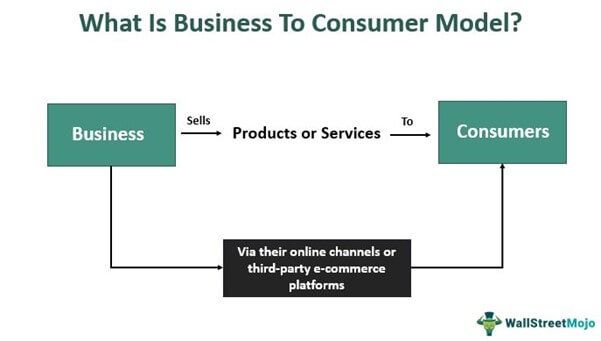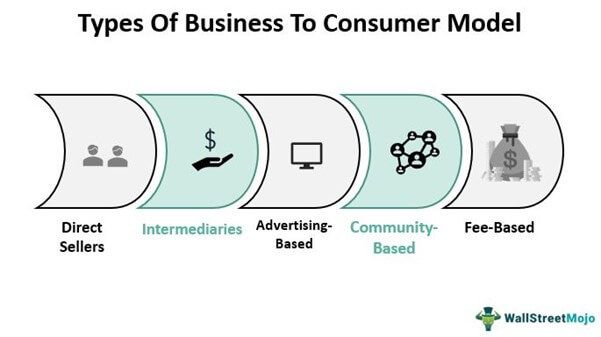Table Of Contents
What Is Business To Consumer?
Business to Consumer (B2C) is a business model where businesses sell their products and services to end-users or customers. It allows companies to engage in direct commercial activities with consumers, enabling the latter to have greater accessibility to the former's products and services.

When customers get a chance to interact with the business directly, they trust those brands more than the rest, which reaches them via intermediaries. A few companies sell their products via online channels, while others use third-party e-commerce platforms. The retail market is one of the best examples of a business to consumer marketing model.
Key Takeaways
- Business to Consumer (B2C) is a business model in which companies offer their goods and services to consumers.
- Every company is not always classified as B2C, B2B, G2B, or B2G. A company could use a hybrid model.
- The B2C model includes direct sellers, intermediaries, advertising-based, community-based, and fee-based platforms.
- A few businesses sell their products through their websites, while others rely on third-party e-commerce platforms.
- While the B2C model has a larger number of customers, the revenue is lower due to shorter sales cycles.
Business To Consumer Explained
The business to consumer marketing approach is always effective given the common platform businesses and consumers share. Michael Aldrich, an English innovator, originally presented the concept in 1979. It is one of the business models that operate around, which also include:
- Business to Business (B2B), where companies sell their products and services to other companies.
- Consumer to Consumer (C2C), where one customer sells the products and services to other customers.
- Business to Government (B2G), where companies sell products to the government, for example, the sale of defense equipment.
- Government to Business (G2B), where the government agencies sell required information to businesses.
- Government to Consumer (G2C), where the government sells the documents asked for by individual customers when required.
At one time, a retailer had a brick-and-mortar store where customers could purchase its goods. Now, online platforms enable customers to interact with the brands and purchase directly. A B2C business must maintain good relations with consumers.
Business to consumer e-commerce websites gives customers access to a range of products. It allows them to explore all relevant product information online to help them make a well-informed and smart purchase.
The B2C model might recognize brands that sell their products directly to consumers. But the businesses that connect the buyers and sellers through their platforms also fall under the B2C category. While the B2C business model has a higher number of clients, the revenue is lower as the sales cycles tend to be shorter. On the other hand, a B2B model has a small number of clients who make bulk purchases, helping the brands earn better revenue with longer sales cycles.
Types
Not every business is necessarily categorized as B2C or B2B or G2B, or B2G. Instead, a brand might have a hybrid model. For example, a brand can have the B2B model, which sells its items to a retail business, and the B2C model, which sells directly to consumers. However, the B2C model can be classified into five types based on how they target customers online:

#1 - Direct Sellers
Businesses, especially small or manufacturing entities, sell goods and services directly to customers. These can be online retailers set up by brands to purchase their products. For example, if customers want to buy a Dell laptop, they can go to the manufacturer’s website directly, gather product information, and order it. Similarly, a business targeting fitness enthusiasts might sell mini trampolines for exercise directly to consumers, allowing them to explore product details and make informed purchases.
#2 - Intermediaries
Online platforms connect brands and customers and help the latter buy and the former sell the products. They do not own products and instead sell them from various manufacturers on their websites. For example, Amazon.com and ebay sell branded items to consumers. These intermediaries profit from a percentage of the product sales.
#3 - Advertising-Based
It is the B2C method whereby companies advertise their products and services on a platform with significant reach. Through this, they make sure more and more people would come to know about their offerings and click on the ads to make a purchase.
Businesses identify their target customers using content traffic-driving tactics and accordingly opt for the platform that would be the most effective to advertise the products.
YouTube and Reddit are advertisement-based businesses that earn by selling advertising space on their platforms. On the other hand, sellers generate revenue by getting the leads converted.
#4 - Community-Based
Businesses use community-based platforms that host like-minded people's ideas, opinions, or interests and host targeted advertisements. It helps brands promote and sell their products and services directly to customers.
For example, advertising baby products on a popular parenting portal would be more effective than using space on a news website. Facebook, Quora, etc., are some platforms where the community-based B2C model can easily be pulled up.
#5 - Fee-Based
Whether it is Spotify or Netflix, there comes the point where the service provider requests a premium subscription to have access to additional content. They are fee-based B2C players.
Examples
Let us consider the following examples to understand the concept better:
Example 1
Ms. A designs beautiful outfits for different occasions. However, instead of paying for a rented space to sell the product, she registers with an online platform that helps it connect with the customers directly. Through this, she had an opportunity to connect with the buyers personally through reviews and customization provisions, which helped her improve the quality per their preference and affordability.
Example 2
Amazon.com is one of the business to consumer examples. Although the e-commerce website acts as an online platform for other businesses' products, it also sells its services like Amazon Prime and Amazon Originals. These Amazon divisions' services are delivered directly to customers.
Advantages & Disadvantages
Business to consumer approach has vital importance when it comes to quality delivery and improvement scope per feedback. However, the approach has its own set of disadvantages as well. Before the buyers choose this mode of purchase, it is important for them to be aware of the pros and cons of this system.
Let us have a look at the benefits and limitations of the process:
| Advantages | Disadvantages |
|---|---|
| Consumers get a wide array of products to choose from. | Sometimes, brands miss updating the list of products available. |
| The cost of doing business is less. Hence, brands get expenses reduced to be utilized in some other productive business activities. | Ease of choosing and buying helps reduce the competition gap. |
| No geographical boundaries as brands get a wider reach. | The presentation expected from customers might be different from what is actually displayed on the platform. Hence, brand reputation is at stake. |
| Technologically sound infrastructure is required for a proper browsing of product lists for better buying decisions. | |
| No middlemen involved | |
| Builds stronger customer relationships |

